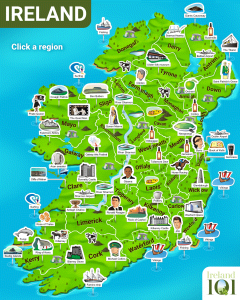Irish history - Grace O'Malley (Gráinne Ní Mháille)
It is difficult to pin point Grace's exact birth and death but she was thought to have been born around 1530 and died in approximately 1603. Grace O'Malley or Gráinne Ní Mháille (was also known as Granuaile, Gráinne Mhaol, Gráinne Ui Mháille, Gráinne Umhaill, Grany O'Maly, Grany Imallye, Granny Nye Male, Grany O'Mayle, Granie ny Maille, Granny ni Maille, Grany O'Mally, Grayn Ny Mayle, Grane ne Male, Grainy O'Maly, and Granee O'Maillieor sometimes even “O’Mealey” is an important figure in Irish folklore, and a historical figure in 1600 Irish history. O'Malley is sometimes known as “The Sea Queen Of Connaught”.
*** CLICK HERE TO SUPPORT OUR GRACE O'MALLEY CASTLE UPGRADE PROJECT ON CLARE ISLAND ***
https://www.ireland101.com/tsp-view/grace-omalley-castle
Gráinne Ní Mháille was born in Ireland around 1530, when Henry VIII was King of England and (at least in name) Lord of Ireland. Under the policies of the English government at the time, the semi-autonomous Irish princes and lords were left mostly to their own devices. However this was to change over the course of her life as the Tudor re-conquest of Ireland gathered pace.
She was the daughter of Eoghan Dubhdara Ó Máille, chieftain of the Ó Máille clan and a direct descendant of its epynom, Maille mac Conall. The Ó Máilles controlled most of what is now the barony of Murrisk in South-West County Mayo and recognized as their nominal overlords the Gaelicized Anglo-Norman Burke or de Burgo family who controlled much of what is now that county. Her mother, Margaret, was also a Ní Mháille. In the Irish language surnames have a feminine and a masculine form. Ní Mháille is the femine form corresponding to the masculine form Ó Máille. Although she was the only child of Dubhdara and his wife, Gráinne Ní Mháille had a half-brother, called Dónal na Piopa (Donal of the Pipes), who was the son of her father.
Unusual among the Irish nobility of the time, the Ó Máilles were a seafaring family and taxed all those who fished off their coasts, which included fishermen from as far away as England. Their leader bore the ancient Irish title of “An Ó Máille” (“The O’Malley”, or “The O’Mealey” – as the name is also anglicised).
According to Irish legend, as a young girl Ní Mháille wished to go on a trading expedition to Spain with her father, and on being told she could not because her long hair would catch in the ship’s ropes, she cut off most of her hair to embarrass her father into taking her, thus earning her the nickname “Gráinne Mhaol” (Irish pronunciation: ['gr??n?? ve?l]; from maol bald or having cropped hair). The name stuck, and was usually anglicised as Granuaile.
As a child she most likely lived at her family's residence of Belclare and Clare Island, but she may have been fostered to another family since fosterage was traditional among Irish nobility at the time.
Ní Mháille was probably formally educated, since she is believed to have spoken in Latin with Queen Elizabeth I at their historic meeting in 1593. Because of her extensive travels and trade, she may have spoken some English, Spanish, Scottish Gaelic, and French as well.
Even as a young woman Gráinne Ní Mháille was involved in the business of sailing ships and international trade. She probably learned the business from her father, Eoghan “Dubhdara” Ó Máille, who plied a busy international shipping trade. It is known that she always wanted to join his fleets, but he always refused. Bunowen Castle, where she lived with her first husband, Dónal an-Chogaidh O'Flaherty, was situated on the most western point in Connacht, and was apparently the first base for her shipping and trade activities. By the time of Donal's death in the early 1560s, she commanded the loyalty of so many O'Flaherty men that many of them left the area when she did, and followed her to Clare Island in Clew Bay, where she moved her headquarters.

_(2).jpg)
